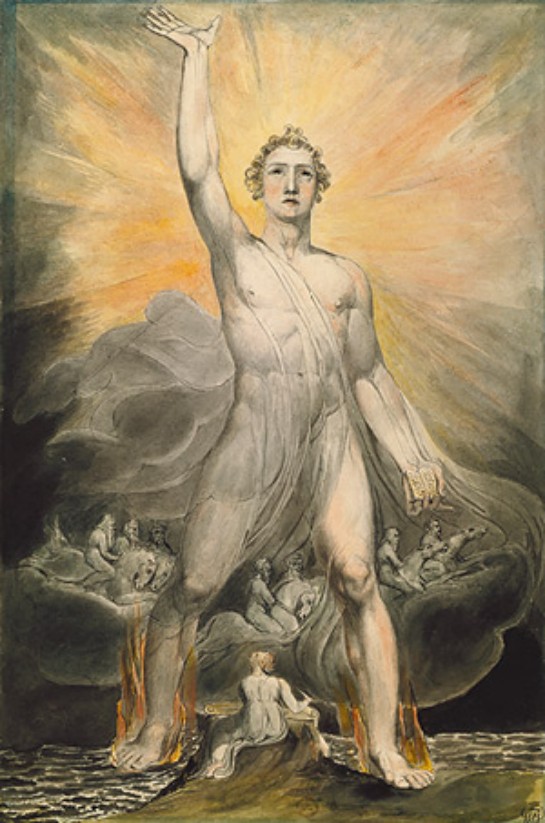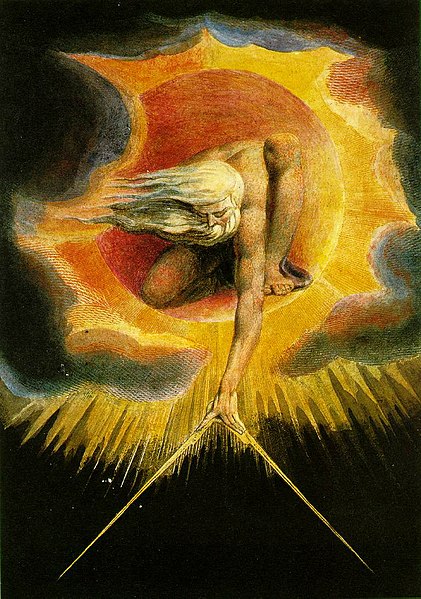William Blake, the first American exhibition of works in all media – drawings, paintings, and prints – by the legendary British Romantic, was on display at The Metropolitan Museum of Art March 29 – June 24, 2001. More than 175 works, including all of the illuminated books, for which he is most widely known, were on view in this first-ever exhibition to explore the artist's work within the context of the social, economic, and political upheavals of his times.
Many of the artist's greatest works were on view, including the apocalyptic

Angel of the Revelation (ca. 1803-05, The Metropolitan Museum of Art),
the celebrated

Ancient of Days (ca. 1824, The Whitworth Art Gallery, The University of Manchester),
the powerful and iconic large color prints

Nebuchadnezzar

and Newton (both ca. 1805, Tate Britain),
and a rare tempera painting,

Ghost of a Flea (ca. 1819-20, Tate Britain).
The exhibition was organized by Tate Britain.
Other highlights of William Blake included two of Blake's original copperplates and one original woodblock, a bronze cast of the artist's life mask, his manuscript notebook, an autograph letter, and examples from all of his vibrantly colored illuminated books.
Rare loans, including

The Man Who Taught Blake Painting in his Dreams, ca. 1819-20,
were also on view.
The exhibition placed special emphasis on the artist's most intense period of work, ca. 1791 to 1800. During this time, Blake invented his extraordinary method of relief etching – a process that allowed for the simultaneous development of word and image directly on the copperplate – and has only recently become fully understood by scholars.
William Blake was born in London in 1757 into a working-class family (his father was a hosier) with strong nonconformist religious beliefs, and was trained as a commercial engraver. Assisted by Catherine Boucher – a grocer's daughter whom he married in 1782 – Blake produced a remarkable series of color-printed books using his relief etching process. William Blake never traveled outside of Britain and remained poor all his life. Aside from a brief period on the southern coast of England (where he worked for the poet William Hayley in Eartham from 1800 to 1803), he spent his entire life in London. At his death in 1827, Blake was mourned by a small group of intimate associates, some of them followers who called themselves the "Ancients"; today, he is celebrated as one of the most original and important artists and poets of the Romantic era.
William Blake was arranged thematically, beginning with an exploration of artist's lifelong engagement with medieval art.
Among the highlights of this section were early studies of tombs in Westminster Abbey, the monumental engraving of Chaucer's

Canterbury Pilgrims (ca.1820, Yale Center for British Art),
and remarkable watercolor illustrations for



Dante's Divine Comedy (ca.1824-27, Tate Britain)

and Edward Young's Night Thoughts (1779, The British Museum).
Engravings including Job (1793, The Keynes Family Trust) and Edward and Eleanor (1793, The British Museum), and illuminated books including America, a Prophesy (1793, The British Museum, National Gallery of Art, and the Library of Congress), The Daughters of Albion (1793, Library of Congress), the Book of Thel (1789, The Pierpont Morgan Library), and The Marriage of Heaven and Hell (1790, The Pierpont Morgan Library), among others, highlighteed the artist's unique iconography. Many of these works were listed in the artist's 1793 prospectus of works offered for sale in his Lambeth workshop. At the time, Lambeth was a poor London neighborhood where Britain's most radical politics found expression, especially in the age of the French and American revolutions. Blake's illustrated books, which have traditionally drawn wide appeal – including The Songs of Innocence and The Songs of Experience – were shown in this section of the exhibition, and will be interpreted within the context of the political upheavals and social concerns of the era.
The Songs of Innocence and of Experience is the best known of Blake's works. Originally, Blake produced this minute and colorful volume as two separate books; he combined them in 1794, and continued to print copies from the original relief-etched copper plates throughout his life. Blake claimed to have learned this innovative printing technique in a vision – one of many he claimed to have experienced throughout his life – from his deceased younger brother, Robert.
More copies of The Songs are known than any of Blake's other illuminated books, and each is unique, distinguished by the coloring of the plates, and, in some instances, by the reordering of the pages.
In The Songs, as in all of Blake's illuminated books, the artist and poet took unprecedented control over every aspect of production. He composed the poems, drew the designs, transferred each onto the copperplate, exposed the plates to an acid bath, and, with Catherine's assistance, printed the plates using a large rolling press he kept in his home. Blake mixed his own colors and painted each sheet by hand; he bound the pages to boards. In this way, Blake not only saved the expense of a printer, he was able to work discreetly, avoiding scrutiny and the very real possibility of censorship and possible imprisonment. Moreover, he maintained the artistic and political integrity of a work in which Blake-the-poet, Blake-the-artist, Blake-the-radical, and Blake-the-religious visionary present the opposing forces of the human condition: the faith and acceptance that are the hallmarks of innocence, and the disillusionment and anger that can result from experience.
The culmination of Blake's dark prophetic vision was represented by a series of large color prints, ca. 1795-1800. Each of these majestic monoprints is unique, pulled from a design painted on millboard, and worked up in pen and ink. Presented without texts, these powerful images take their monumental figures from the Bible, Shakespeare, and other literary sources. Blake's designs for Milton, and his important late illustrated poems – The Four Valas (c.1797-1807, The British Library Board), the Book of Los (1795, The British Museum), the Song of Los (1795, The British Museum), and Europe a Prophesy (1794, Glasgow University Library and The British Museum) – are masterpieces of the artist's maturity and were highlights of William Blake. Several plates from Jerusalem (1804-20, The Metropolitan Museum of Art and The British Museum), Blake's largest and arguably most ambitious work, was also on view.
Publication
A full-color catalogue, published by The Metropolitan Museum of Art and distributed in North America by Harry N. Abrams, Inc., accompanied the Metropolitan's presentation of William Blake. It includes essays by biographer and historian Peter Ackroyd, and literary scholar Marilyn Butler, with additional contributions from curators at Tate Britain and The Metropolitan Museum of Art.
William Blake was organized by Robin Hamlyn, Senior Curator, Tate Collections, for the period 1780-1860, and Michael Phillips, Reader at the University of York. At the Metropolitan, the exhibition is organized by Elizabeth Barker, Assistant Curator in the Department of Drawings and Prints.